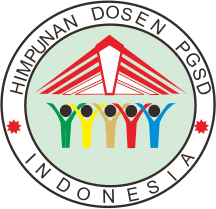Analisis kemampuan pemecahan masalah materi kecepatan dan debit berdasarkan teori john dewey pada peserta didik kelas 5 sekolah dasar
Abstract
This aim of this research is to describe the ability to solve problems in speed and debit material based on John Dewey's theory on the 5th grade students of SD Djama'atul Ichwan Surakarta in the academic year 2019/2020. The method used in this research is descriptive qualitative with a phenomenological approach. The data source of this study was students of grade 5Bth at SD Djama'atul Ichwan, consisting of six children as research samples were taken by using a purposive sampling technique . The data collection technique was carried out by observation, interview, and document analysis with data validity testing using technique triangulation and time triangulation. Data were analyzed using the Miles and Huberman data analysis models. The results of this study indicate that students can determine the problem by meeting the two specified indicators. Students are quite able to formulate and evaluate problem-solving hypotheses because they only have one way as an alternative to problem-solving so that they only meet one indicator out of the two indicators set. Students are quite capable of applying the chosen problem-solving method because they have not been able to write problem-solving steps systematically so that they only meet three indicators out of the four indicators set. It can be concluded that the students did not succeed in meeting the indicators determining several alternative problem-solving and indicators of the problem-solving flow were written systematically. The result of this research provide insight into problem-solving abilities based on John Dewey’s theory and orm the basis of the further research. The result of this research also encourage teachers to determine effective strategies, models, and methods so they can improve students’ problem solving abilities.
Keywords
Full Text:
PDFReferences
F Shadiq 2014 Pembelajaran Matematika (Yogyakarta: Graha Ilmu) [2] S Prabawanto 2017 The Enhancement of Students’ Mathematical Problem Solving Ability through Teaching with Metacognitive Scaffolding Approach Am. Inst. Phys. 040014 1–6 [3] G Saputro, J I Poerwanti, and Chumdari 2018 Peningkatan Kemampuan Menyelesaikan Soal Cerita melalui Model Pembelajaran Realistic Mathematics Education pada Siswa Sekolah Dasar J. Didakt. Dwija Indria 6(8) 85–91 [4] M Winditasari, H Soegiyanto, and S Kamsiyati 2018 Peningkatan Kemampuan Pemecahan Masalah pada Materi Waktu, Jarak, dan Kecepatan melalui Penerapan Model Pembelajaran Auditory, Intellectually, Repetition (AIR) pada Siswa Sekolah Dasar J. Didakt. Dwija Indria 6(8) 151–158 [5] J P Mairing 2017 Students’ Abilities to Solve Mathematical Problems According to Accreditation Levels Int. J. Educ. 10(1) 1–11 [6] A Al Rohmah 2019 Analisis Keterampilan Pemecahan Masalah Materi Operasi Hitung Pembagian pada Peserta Didik Sekolah Dasar J. Didakt. Dwija Indria 7(2) [7] Zulfah 2017 Pengaruh Penerapan Model Pembelajaran Kooperatif Think Pair Share dengan Pendekatan Heuristik terhadap Kemampuan Pemecahan Masalah Matematis Siswa MTs Negeri Naumbai Kecamatan Kampar J. Cendekia J. Pendidik. Mat. 1(2) 1–12 [8] K E Lestari and M R Yudhanegara 2017 Penelitian Pendidikan Matematika (Bandung: PT Refika Aditama) [9] H Hendriana and U Soemarmo 2014 Penilaian Pembelajaran Matematika (Bandung: PT Refika Aditama) [10] P Akbar, A Hamid, M Bernard, and A I Sugandi 2018 Analisis Kemampuan Pemecahan Masalah dan Disposisi Matematik Siswa Kelas XI SMA Putra Juang dalam Materi Peluang J. Pendidik. Mat. 2(1) 144–153 [11] L P A Arum and P Wijayanti 2017 Profil Berpikir Reflektif Siswa SMP dalam Memecahkan Masalah Aljabar Ditinjau dari Perbedaan Jenis Kelamin J. Ilm. Pendidik. Mat. 2(6) [12] A Fuady 2017 Berfikir Reflektif dalam Pembelajaran Matematika J. Ilm. Pendidik. Mat. 1(2) 104–112 [13] U Kusdinar, Sukestiyarno, Isnarto, and A Istiandaru 2017 Krulik and Rudnik Model Heuristic Strategy in Mathematics Problem Solving Int. J. Emerg. Math. Educ. 1(2) 205–210 [14] M A Rasyid, M T Budiarto, and A Lukito 2017 Profil Berpikir Reflektif Siswa SMP dalam Pemecahan Masalah Pecahan Ditinjau dari Perbedaan Gender J. Mat. Kreat. 8(2) 171–181 [15] Y Miarso 2011 Menyemai Benih Teknologi Pendidikan (Jakarta: Prenada Media Group) [16] Trisniawati 2017 Analisis Kemampuan Pemecahan Masalah Matematis Siswa Tingkat Sekolah Dasar di Kotamadya Yogyakarta J. Ilm. Ilmu Pengetah. dan Teknol. 3(1) 1–10 [17] V M Rianto, E Yusmin, and A Nursangaji 2017 Kemampuan Pemecahan Masalah Siswa Berdasarkan Teori John Dewey Pada Materi Trigonometri J. Pendidik. dan Pembelajaran 6(7) [18] G Roebyanto and S Harmini 2017 Pemecahan Masalah Matematika untuk PGSD (Bandung: PT Remaja Rosdakarya)
Refbacks
- There are currently no refbacks.



